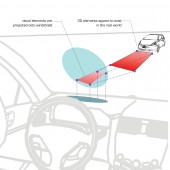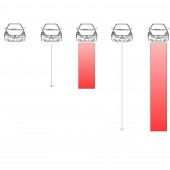DESIGN NAME:
Projected Path
PRIMARY FUNCTION:
Vehicular Augmented Reality
INSPIRATION:
We were motivated to use augmented reality in a useful way that truly helps the driver, more than as a distraction or technical feature. Because safety is such a huge issue with driving, we wanted to tackle a single problem well using the 3D Heads-Up Display. That is why we chose to do the Left Turn Aid. Ultimately this represents a form of preventative safety, a kind of pro-active approach to safety where the driver corrects their mistakes and increases their overall awareness and safety over time.
UNIQUE PROPERTIES / PROJECT DESCRIPTION:
Using an augmented reality heads-up display in the car windshield, this design shows the projected 3 second path of vehicles in the driver's environment. Spurred on by the danger of turning across traffic, this design addresses the human inability to judge the speed of oncoming vehicles. The speed of oncoming cars are detected and a red "danger zone" Projected Path is shown through the heads up display. Now the driver can safely turn when the intersection is free of red Projected Paths.
OPERATION / FLOW / INTERACTION:
When the driver enters the turn lane or signals to turn, the Left Turn Aid's "Projected Paths" appear. These appear to be an area on the ground that moves along with cars in the driver's field of view, which is augmented via heads-up display. The faster oncoming cars are travelling, the longer the 3 second Projected Path is. They wait until the intersection is free of red paths from other cars and then he or she proceeds safely through the intersection.
PROJECT DURATION AND LOCATION:
June 2012 to February 2013
FITS BEST INTO CATEGORY:
Idea and Conceptual Design
|
PRODUCTION / REALIZATION TECHNOLOGY:
This design uses a 3D Heads-up Display (3D HUD). Because we have a working prototype for this 3D HUD, we can design immersive augmented reality visuals that appear to actually appear in the environment, including perspective, focal distance, and parallax. The visuals do not appear on the windshield itself but actually in the road to the driver's perspective. Using computer vision and sensor techniques we are able to detect the speed and trajectory of other vehicles.
SPECIFICATIONS / TECHNICAL PROPERTIES:
The red Projected Path shows where the oncoming car will be in the next 3 seconds by multiplying its speed by time. Using computer vision algorithms and visual sensors, the driver's own car can detect the speed of cars in its environment. The heads-up display used in the car is a volumetric HUD, meaning it shows true 3D visuals that appear at the correct focal depth.
TAGS:
augmented reality, heads-up display, AR, HUD, driving, safety, car, traffic, oncoming, preventative
RESEARCH ABSTRACT:
Research initially began with statistical research into high accident causing scenarios. Turning left across traffic (in the US) is disproportionately dangerous because a small accident can result in fatal head-on collisions. Especially elderly people are susceptible to this. We have designed and prototyped this design in a driving simulator and tested in on users. Currently users appear to understand and value the design. We are currently preparing a full scientific study.
CHALLENGE:
The hardest part of this design and research challenge was properly solving the left turn scenario using 3 dimensional graphics. Because our 3D Heads-Up Display can show objects in correct perspective and focal depth, ordinary 2D designs would not have sufficed. The original proposed concept showed the driver when he/she could turn safely. Instead it turned out that showing the "danger zone" was a more graceful solution.
ADDED DATE:
2013-02-27 17:38:03
TEAM MEMBERS (4) :
Lee Beckwith, Karlin Bark, Victor Ng-Thow-Hing and Cuong Tran
IMAGE CREDITS:
Lee Beckwith & Victor Ng-Thow-Hing, 2012.
|










